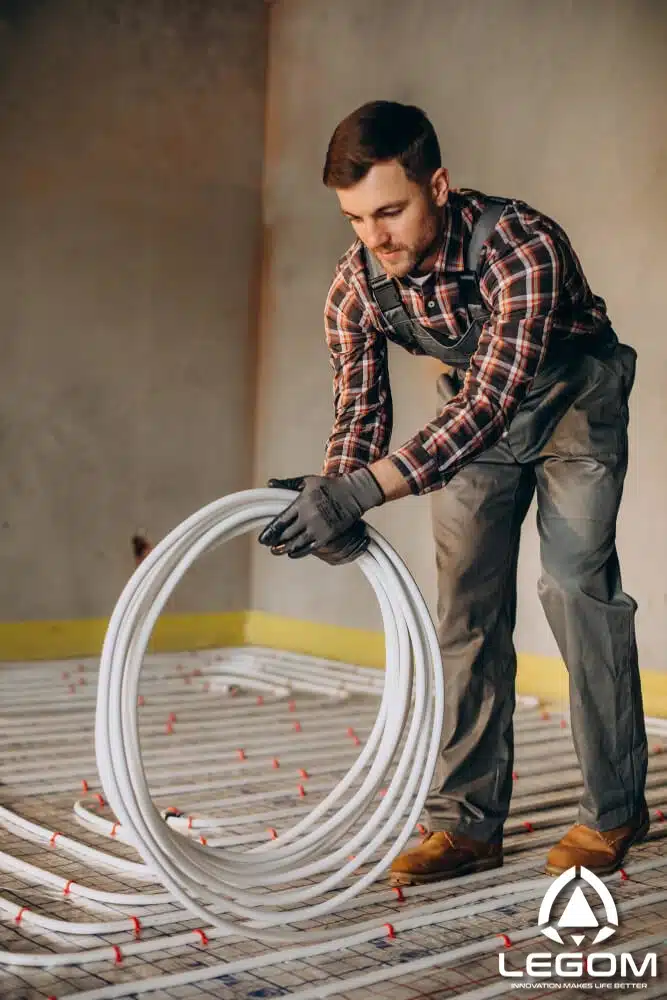Radiant floor heating installation offers numerous benefits compared to traditional heating methods. This increasingly popular option has already shown its advantages to homeowners. Even right after the technician installs the floor heating, you can start feeling the benefits.
Radiant floor heating operates silently, creating a quieter home environment compared to noisy traditional heating systems. It also provides comfort for your bare feet as you walk through the house, even when you go to the bathroom or kitchen.
This system consistently eliminates cold from the ground up, ensuring even heating throughout the house once the heater is turned on. After using it for a while, you will also notice the energy efficiency of radiant floor heating.
It provides warmth that rises evenly from below, allowing you to reduce thermostat settings and gradually lower energy consumption. This makes it much more efficient than forced-air systems or other types of floor heating.
Consistently warm floors during extreme winter weather can significantly improve your quality of life. You’ll be eager to wake up without worrying about stepping out of bed onto a cold floor. Before deciding to install radiant heating, it’s wise to learn about the different types of radiant floor heating and assess your home’s compatibility.
Contents
Types of Radiant Floor Heating Installation
Before installing radiant floor heating, it’s important to understand the different types available. Each type has specific characteristics and varying levels of compatibility with different buildings. Regardless of the type, the system works by using a heat source hidden beneath the floor.
Radiant floor heating works by raising the temperature evenly, with hot air replacing cooler air in the room above. This process does not disturb dust or small particles. The primary principle of radiant heating is to reduce airflow, making the surrounding air more comfortable and cleaner than before installation. When it comes to installation, you can choose between wet or dry methods.
Wet Installation of Radiant Floor Heating
Wet installation involves embedding various tools and equipment within thick concrete slabs. Thin concrete floors can also be used to support electrical cables, mats, or hydraulic pipes for wet installations. This type of installation takes longer to heat a room, but the warmth remains even when the system is turned off.
The large thermal mass retains heat more effectively, making the warm temperature last longer. This is why wet installation tends to be more expensive than dry installation.
Dry Installation of Radiant Floor Heating
Dry installation is easier and more cost-effective. All equipment, such as heating cables, mats, and pipes, is placed in air pockets beneath the floor. This results in faster heating compared to a wet system. However, the configuration requires higher temperatures to achieve the desired warmth.
Radiant Floor Heating Installation: Hydronic vs. Electric Systems
Radiant floor heating systems come in two main types: hydronic and electric. Both require different tools and installation methods. Here’s how you can install each type to make your home more comfortable.
Hydronic Radiant Floor Heating
For hydronic radiant floor heating, you’ll need the following equipment: PEX pipe, PEX oxygen barrier tube, fiberglass insulation, aluminum heat transfer plates, PEX pipe tools, a 7/8 inch drill bit, a shovel, and a Forstner bit. Follow these steps for installation:
- Create a Layout: Mark the layout on the ceiling, making marks in six-inch increments where the heating pipe will go. Also, mark where the pipe will pass through the floor joist.
- Drill Pipe Holes: Drill 7/8 inch holes in the floor joists for the pipes. If you prefer not to drill, you can purchase pre-drilled floor joists.
- Install the Pipes: Insert the PEX pipes into the aluminum heat exchanger plates. Secure the plates to the underside of the floor with staples, following the layout you marked earlier. Insert the PEX pipes through the holes in the joists, leaving about two feet of extra pipe on both ends for the hot water connection.
- Install the Insulation: Clamp the insulation in place, ensuring that about two feet of the heating pipe remain exposed.
- Connect the Pipes to the Heat Source: You’ll need a professional technician to connect the pipes to a dedicated water heating system. This step requires expertise in hot water heating loops.

Electric Radiant Floor Heating
For electric radiant floor heating, you’ll need a drill mixer, electric cable, mixing bucket, electric radiant heating mat, a thermostat compatible with floor heating, and a floor leveling compound. Follow these steps for installation:
- Prepare the Underfloor Area: Clean the underfloor area thoroughly. Lay the electric heating mat to cover most of the floor according to your desired pattern. Ensure that the base is level with no overlaps. Secure the base or cables to the floor below, following the manufacturer’s instructions.
- Place the Thermocouple: Position the thermocouple and its base at least 12 inches from the wall, ideally close to the center of the floor. Collect the cables from the thermocouple and each base.
- Place the Cables: Run the cables along the wall to the electrical connection point. Ensure three feet of insulation from each cable by securing them to the wall above the floor.
- Use a Floor Leveler: Pour the floor leveling compound evenly across the entire floor, ensuring the wires are fully submerged. Allow the mixture to dry for 24 to 72 hours in a safe place.
- Connect the Electricity: Have a professional connect the wires from the mats to the home’s electrical circuit. Follow all building electrical codes. Connect the thermocouple wire to the thermostat, following the wiring instructions provided.
- Install New Flooring: Once the leveling compound has cured, cover everything with new flooring. You can choose laminate, tile, vinyl, linoleum, or carpet with a dense backing.
Looking to Buy Floor Heating Components?
Radiant floor heating installation has become easier thanks to the availability of components and equipment. Legom as the HVAC supplier in China, we offer all the HVAC products needed for professional technicians to install heating systems. Consult with us now!


